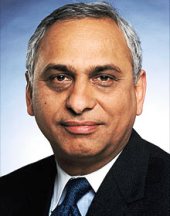 International rating agencies had to face tough questions, and much criticism when their crucial role in the subprime crisis emerged.
International rating agencies had to face tough questions, and much criticism when their crucial role in the subprime crisis emerged.
Ideas of multiple models for ratings were floated along with self-initiated reforms.
But Deven Sharma, president of Standard and Poor's, tells Devjyot Ghoshal that the market and the investor will have the final say on the way forward.
Edited excerpts:
At the end of the financial crisis, accountability and integrity of rating agencies emerged as a key point.
In that, two models -- issuer-pays and investor-pays -- had emerged.
What is S&P's current view on this? Can, and should, these models coexist?
There are multiple types of business models and each model has its strengths as well as potential for conflicts of interest, whether it is issuer-pay, subscriber-pay or a government-run model.
The issuer-pay model brings the most transparency to the markets, as our ratings are made freely available to all on an equal basis.
In contrast, the investor-pay model has its own potential conflicts, and creates a privileged class of subscribers.
Since no model is without conflict, we believe it's important to have oversight, accountability and transparency and let multiple models coexist and compete.
Ultimately, investor and market scrutiny determines the confidence in different models.
Recently, you told a newspaper that post-crisis 'a lot of changes were made in our governance structure' and that 'checks and balances' have been put up. Can you elaborate? What is the underlying principle behind these reforms, if one can put it that way?
We have made significant changes to strengthen our ratings.
That includes reinforcing the integrity and independence of our ratings process, increasing our transparency, and making our ratings more stable, more comparable and more forward-looking.
In addition to the separation of analytical and commercial activities, which we have always done, some examples of further changes include the separation of the quality, criteria and rating functions, and the creation of a compliance group independent of the ratings group; and the establishment of a rotation system and professional certification for analysts.
Our goal is to build investor confidence in the quality and performance of our research and opinions.
Is greater competition fuelling greater transparency among rating agencies?
We welcome free and fair competition. In our view, the more rating opinion is available to investors, assuming they are independent and credible, the better for the market, as investors benefit from a diversity of views about credit risk.
Ultimately, it is up to the market to determine which ratings are credible and useful.
In the past, there were accusations of the functioning of an oligopoly of rating agencies.
Local and regional credit rating agencies have always co-existed in the market, particularly in Asia.
So an oligopoly is more perception than reality.
Competition is a good thing and our guiding principle is that we will compete on the basis of the quality of our product.
In practice, there are significant differences between the major ratings firms in terms of their criteria, ratings and performance. So, investors do have a real choice.
There has been some criticism of S&P's recent downgrading of the US long-term credit outlook. How would you react to this?
The United States is a large and flexible economy and with the dollar as a reserve currency, it has the strengths to cope with the challenges in the short-term, although we recently revised our outlook on the US long-term rating to negative from stable.
This is because of what we consider to be very large budget deficits and rising government indebtedness, and because the path to addressing these issues is not clear to us.
As we look forward, we believe there is a material risk that US policymakers may not reach an agreement on how to address medium-and long-term budgetary challenges by 2013.
If an agreement is not reached and meaningful implementation does not begin by then, this would, in our view, render the US fiscal profile meaningfully weaker than that of other 'AAA' sovereigns.
For S&P, what is the potential in South and Southeast Asia, given the rise of capital markets in the region?
South and Southeast Asia have made remarkable progress in developing their capital markets over the years.
Greater investor participation will help deepen their capital markets as investors look to more opportunities.
Standard & Poor's has been active in South and Southeast Asia for many years.
S&P's local partnership in South Asia includes a majority stake in Crisil, India's leading financial information provider.
In Southeast Asia, we have partnerships with several national rating agencies, including affiliations with Pefindo in Indonesia and Rating Agency of Malaysia.
We believe these efforts will support domestic investors and deepen local capital markets.
We have also been active connecting Southeast Asian markets by offering a new Asean rating benchmark to support the interest among regional investors.
Last week, we launched a Greater China rating scale across Hong Kong, China and Taiwan, to also provide a transparent opinion about credit risk in that region, including the fast-growing renminbi debt market.
Image: Deven Sharma











 © 2025
© 2025